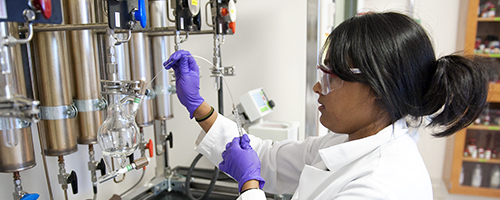Document Type
Article
Publication Date
1-1-2010
Publication Title
Langmuir : the ACS journal of surfaces and colloids
Abstract
We report an approach to the fabrication of free-standing and amine-reactive thin films that is based on the reactive layer-by-layer assembly and subsequent lift-off of azlactone-containing polymer multilayers. We demonstrate that covalently cross-linked multilayers fabricated using the azlactone-functionalized polymer poly(2-vinyl-4,4-dimethylazlactone) (PVDMA) and a primary amine-containing polymer [poly(ethyleneimine) (PEI)] can be delaminated from planar glass and silicon surfaces by immersion in mildly acidic aqueous environments to yield flexible freestanding membranes. These free-standing membranes are robust and can withstand exposure to strong acid, strong base, or incubation in high ionic strength solutions that typically lead to the disruption and erosion of polymer multilayers assembled by reversible weak interactions (e.g., "polyelectrolyte multilayers" assembled by electrostatic interactions or hydrogen bonding). We demonstrate further that these PEI/PVDMA assemblies contain residual reactive azlactone functionality that can be exploited to chemically modify the films (either directly after fabrication or after they have been lifted off of the substrates on which they were fabricated) using a variety of amine-functionalized small molecules. These free-standing membranes can also be transferred readily onto other objects (for example, onto the surfaces of planar substrates containing holes or pores) to fabricate suspended polymer membranes and other film-functionalized interfaces. In addition to planar, two-dimensional free-standing films, this approach can be used to fabricate and isolate three-dimensional free-standing membranes (e.g., curved films or tubes) by layer-by-layer assembly on, and subsequent lift-off from, the surfaces of topologically complex substrates (e.g., the curved ends of glass tubing, etc.). The results of this investigation, when combined, suggest the basis of methods for the fabrication of stable, chemically reactive, and flexible polymer thin films and membranes of potential utility in a variety of fundamental and applied contexts.
Volume
26
Issue
20
First Page
16134
Last Page
16140
DOI
10.1021/la103009a
Recommended Citation
Buck, Maren E. and Lynn, David M., "Free-Standing and Reactive Thin Films Fabricated by Covalent Layer-by-Layer Assembly and Subsequent Lift-Off of Azlactone-Containing Polymer Multilayers" (2010). Chemistry: Faculty Publications, Smith College, Northampton, MA.
https://scholarworks.smith.edu/chm_facpubs/35



Comments
Peer reviewed accepted manuscript.